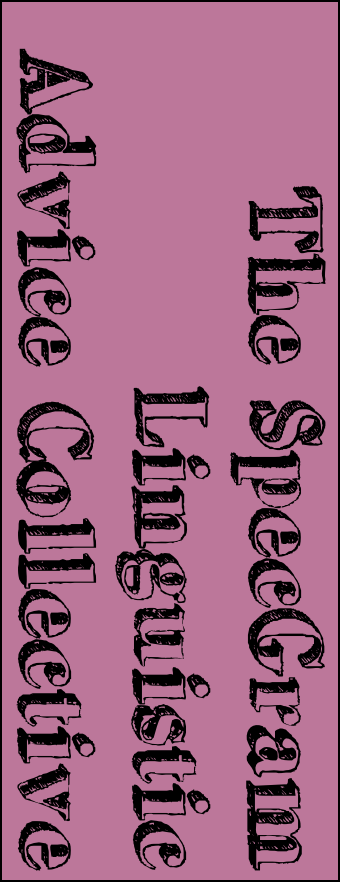


Are you in a world of linguistic hurt? The SpecGram Linguistic Advice Collective (SLAC) will offer you empirical, empathic, emphatic advice you can use!*

Remember, if you can tell the difference between good advice and bad advice, then you don’t need advice! So, if you need advice, trust us
Dear SLAC,
I am not an aficionado of sportsball or related activities, but I do not wish to seem entirely unschooled in the art of sports-
Thanks,
—Notta Jacques
Dear All Hat, No Prattle,
Technically, “hat trick” can be used to denote three goals in any sport. In response, sports aficionados have been known to wear different hats to different sporting events. Due to the rarity of hat tricks in soccer, fans often wear fascinators or other elaborate headpieces. (Those who don’t are termed “hooligans”.) In basketball, fans refrain from wearing anything on their head, excluding people pointlessly cheering for the New York Knicks.
In hockey, a “Gordie Howe hat trick” refers to a goal, an assist, and a fight in the same game. Gordie Howe hat tricks are rare in other sports. Dennis Rodman once achieved that honor, ironically as a spectator at a baseball game.
—SLAC Unit #56696e63656e74
Dear No To Yaks,
A great question! Hats off to you. As to the meaning of the compound, it adheres to one of the standard noun-
Football originated among the gentrified yeoman classes of late 18th century Victorian Scotland. As is well known, these gentlemen used their many hours of leisure to play sports of all kinds and more. Bedecked in hats, and with a cultural propensity for magic sideshows, it became customary for a goal, point, or any form of victory to be celebrated by a trick with a hat (rabbit out of; cutting hat in half etc.) On completion of the trick, the hat was to be worn by the goal-/
As for how to use it conversation, try these conversational openers: Do you like hat tricks? Does anyone you know like hat tricks? What the best thing about hat tricks in your view? Would you go on holiday with a hat trick?
—SLAC Unit #4465616b
Dear ceci n’est pas Jacques,
Those explanations given by the previous SLAC Units are all too complicated to be plausible. Isn’t there some philosophy rule about how the simplest explanation is always true? Named after a sort of knife or blade? Anyhow, in actuality, a “hat trick” is simply any performance, in any context, which is impressive enough to prompt the response of “I’ll eat my hat!”. Not necessarily literally, although if you were to actually ingest a hat, that would probably constitute a hat trick for most, setting off a chain reaction of haberdasherophagy. Anyhow, to discern the social norms of hat trickery, you’ll have to simply spend more time with sportsball fans.
—SLAC Unit #456d696c79
Dear Naughty Strap,
SLAC Unit #456d696c79 is correct that many of these explanations are too complicated. There’s also a dearth of useful advice
Which reminds me, I’ve heard another explanation for the source of “hat trick”, which SLAC Unit #4465616b told me about, though he apparently discounted it as even more far fetched than the etymology he previously gave. Here it is for your amusement:
Initially it was a cricketing term, but historically took the form ‘That rocks’, this being a standard supportive chat in cricketing circles. Then, in 1923, at Lords, a young boy by the name of Stephen Huss was being taught by his milliner (whose name is lost to history) how to chant ‘That rocks, that rocks’ whenever a 6 was hit. Alas, he misread the phrase in his excitement and transposed the initial <t> onto ‘rock’. His subsequent loud chants of ‘Hat trocks’ cannoned round that stadium and the phrase passed into the sporting constructicon. (The [o] → [i] shift was of course part of the Great Vowel Shift of 1938.)
Of course, in addition to being wrong, it’s not relevant to your actual question, which is how to properly use “hat trick” in sportsball-
(Un)Fortunately, I don’t have an answer to that. It’s unfortunate for you, because you are no closer to figuring out how to behave around normal people without seeming like a weirdo (yeah, me neither). But it’s fortunate for me since, having met my contractually obligated quarterly word count for SLAC
—SLAC Unit #54726579
Dear Don’t-
The best time to use the term “hat trick” is when there are rabbits on the pitch.
—SLAC Unit #50657465
Dear Notty Jokes,
The best way to avoid misusing “hat trick”, or any other sporting term, is to avoid all sports to which it could possibly pertain, or indeed, all sports to which any terms could possibly pertain. Or possibly even (if you are a “Type A” personality), all activities which could possibly be considered sports. This leaves pretty much only linguistics, so it’s the solution we mostly adopt around here. And nobody in the SpecGram offices has misused “hat trick” in over 300 years.
—SLAC Unit #4b65697468
Dear Frère Jacques,
I was going to write a sensible comment but I am falling asleep. Obviously a nap takes priority over all else now.
—SLAC Unit #4d61726b
* Advice is not guaranteed to be useful, practical, or even possible. Do not attempt at home. Consult a doctor (of linguistics, philology, or